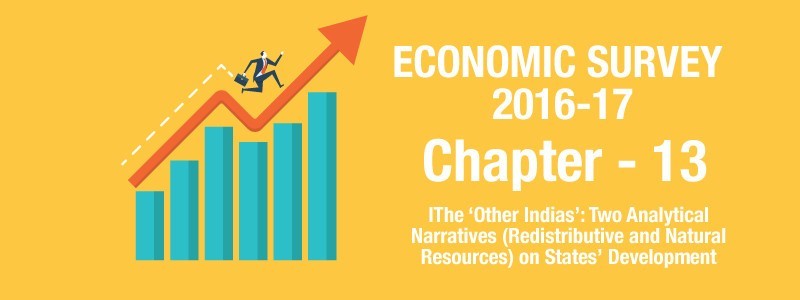Chapter 13 – The ‘Other Indias’ – Highlights of Economic Survey 2016-17
Chapter 13 of the Economic Survey 2016-17 focuses upon various development models found in India and how far states have progressed since Independence. The survey here notes that the government has been less than efficient in providing redistributive justice and promoting social welfare.
Economic Survey 2016-17 identifies three successful models of development found in Peninsular India:
- The traditional East Asian mode of escape from development based on manufacturing (Gujarat and Tamil Nadu);
- The remittance-reliant mode of development exemplified by Kerala;
- “Precocious India” model based on specializing in skilled services (Karnataka, Andhra Pradesh and Tamil Nadu.
There are two other models visible (less developed states), notably,
- Those based on “aid” or special status – The “aid” model is most applicable to the erstwhile ‘Special Category’ states that includes North-eastern states and Jammu and Kashmir;
- Those based on natural resources – the natural resources model to Jharkhand, Chhattisgarh, Odisha, Gujarat and Rajasthan.
The Economic Survey brings in another reference – “Dutch disease”, named after the impact that discovery of natural gas in the North Sea had on the domestic economy in the Netherlands.
*This windfall caused the real exchange rate to appreciate as the extra income was spent domestically, pushing up the price of non-tradeables, such as services geared to the local economy. The higher prices for services then eroded profitability in export and import-competing industries, de-industrializing the economy, with the share of manufacturing in the economy falling.
How can development be achieved?
- Through foreign aid
- Through government aid in the form of transfers and other funds.
- Through utilizing its own natural resources.
Indian development model has largely focused on redistribution through extensive transfers to certain poorer states in an attempt to spur their development.
Economic Survey 2016-17 goes onto introduce another concept – ‘Redistributive Resource Transfers’ (RRT) – RRT to a state is defined as gross devolution to the state adjusted for the respective state’s share in aggregate gross domestic product. Thus RRT is not identical to gross devolution.
The higher the RRT:
- The slower is growth.
- The smaller is the share of manufacturing in GSDP.
- The lower is own tax revenues.
Another concept mentioned in the Economic Survey is “Resource curse” – economies with abundant natural resources have actually tended to grow less rapidly than resource- scarce economies.
The above incidence of resource curse is attributed to
- Exploitation of natural resources generates rents, which lead to rapacious rent seeking (the voracity effect) and increased corruption.
- Natural resource ownership exposes countries to commodity price volatility, which can destabilize GDP growth.
- Natural resource ownership – like foreign aid — makes countries susceptible to “Dutch Disease”
Analysis in the Economic Survey reveals that mineral rich newly formed Indian states like Jharkhand, Chhattisgarh and Odisha too have fallen to this very trap of “Resource Curse”, albeit with some improvement in overall social indicators.
PATH AHEAD TO REDISTRIBUTIVE JUSTICE & FURTHER DEVELOPMENT AS MENTIONED IN ECONOMIC SURVEY 2016-17
- Improving Infrastructure and Connectivity: Enhancing connectivity – financial and physical – on a war footing (as the government has attempted for financial inclusion with the Pradhan Mantri Jan Dhan Yojana (PMJDY), expediting the optical fibre network, etc.) will have a moderating effect.
- Redirecting flows to households: One possibility would be to redirect a certain portion of RRT and channel the resources directly to households as part of a Universal Basic Income (UBI) scheme.
- Conditioning transfers on fiscal performance: Another possibility would to find ways to offset the fiscal bias uncovered by the above analysis, in which higher resource flow leads states to relax their own tax effort.
- Making governance- contingent transfers: To encourage better governance and sound institutional practices, the fund transfer mechanism could explicitly include a few monitorable institutional indicators as criteria for receiving transfers.
- Mines and Minerals (Development and Regulation) Amendment Act, 2015 included the following in the Act:
- Establishment of a trust, to be called the District Mineral Foundation (DMF) for districts affected by mining related operations.
- The composition and functions of DMF are to be prescribed by the respective State governments. The foundation shall work for the benefit and interest of persons affected by mining related operations.
- Citizen’s participation: One way to increase citizens’ participation is via creation of a dedicated Fund to which all mining revenue must accrue.
- An alternative structure would be to redistribute the gains from resource use directly into the accounts of the concerned citizens as part of a UBI.
Also Read : Top 10 Key Highlights of Economic Survey 2016-17 for UPSC Aspirants
Also Read: Chapter wise highlights of Economic Survey 2016-17
Chapter 01 – Economic Outlook and Policy Challenges
Chapter 02 – The Economic Vision for Precocious, Cleavaged India
Chapter 03 – Demonetization: To Deify or Demonize?
Chapter 04 – The Festering Twin Balance Sheet Problem
Chapter-05 – Fiscal Framework: The World is Changing, Should India Change Too?
Chapter 06 – Fiscal Rules: Lessons from the States
Chapter 07 – Clothes and Shoes: Can India Reclaim Low Skill Manufacturing?
Chapter 08 – Review of Economic Developments
Chapter 09 – Universal Basic Income
Chapter 10 – Income, Health, and Fertility: Convergence Puzzles
Chapter 11 – One Economic India
Chapter 12 – India on the Move and Churning
Chapter 13 – The ‘Other Indias’ – Highlights of Economic Survey 2016-17
Chapter 14 – From Competitive Federalism to Competitive Sub-Federalism
Download PDF to your email
*/ ?>The Only Resource Needed To Crack The UPSC Prelims Test 2017
Monthly Current Affairs Archives

 Login
Login

![Salient features of Right to Information [RTI Act ] 2005](http://65.1.154.182/wp-content/uploads/2017/07/SALIENT-FEATURES-OF-RIGHT-TO-INFORMATION-RTI-ACT-2005-FOR-CIVIL-SERVICES-IAS-EXAM-PREPARATION-1-81x66.jpg)
![Right to Information [ RTI Act ] 2005 -Historical Background](http://65.1.154.182/wp-content/uploads/2017/07/RIGHT-TO-INFORMATION-RTI-ACT-2005-FOR-CIVIL-SERVICES-IAS-EXAM-PREPARATION-01-81x66.jpg)













